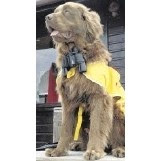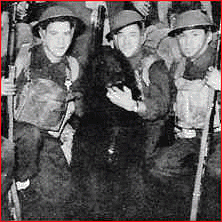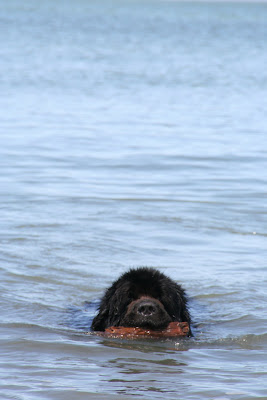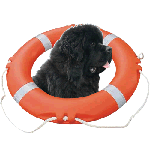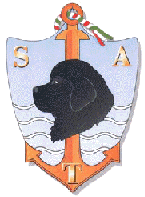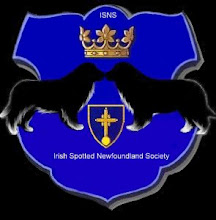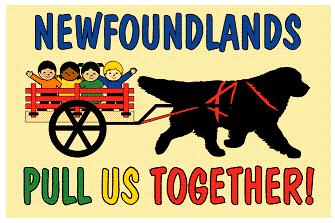

The GGNRA, aided and abetted by such utterly crazed organizations like the Golden Gate Audubon Society, the Center for Biological Diversity, the Native Nazi Societies (something like that), and Coleman Advocates for Screwed Up Children, have illegally closed off 2.2 miles of Ocean Beach and the westerly section of Crissy Field only to dogs, not humans or children or anything else. Their notion (because the science isn't there) is that despite the fact that the areas are non-critical habitat for the Western Snowy Plover ("WSP"), dogs present an "emergency" to the Plover.
Now, just how did this purported emergency come about? Let's see. The Plover was listed as "threatened" in 1993, and dogs have been allowed off leash in these areas since well before that time. So initially, you have to wonder why Plovers would ever frequent a beach where dogs are off leash if dogs actually prey upon them? Later, in 1996, when Lyin Brian O'Neill (Chief Despot of the GGNRA) wanted capital improvements through private funding at Crissy Field, he agreed that in consideration of the funding, he would not close off the westerly portion of the beach. Why wasn't there an emergency when O'Neill needed funding? Moving forward, in June, 2005, at the hearing on appeal regarding the legality of the 1979 Pet Policy, the Court plainly asked the government whether they were claiming an emergency. The answer? "No, You Honor."
So where is the emergency? Putting aside the controversy as to whether the WSP is threatened with extinction or not, the USF&WS Draft Recovery Plan for the WSP answers this question. The Recovery Plan states that the WSP does not nest or breed at the Crissy Field or Ocean Beach locations. The Draft Recovery Plan also indicates that despite implementation of best management practices, these locations hold no promise for the plover to nest or breed there in the future. According to Gary Page of the Point Reyes Bird Observatory (a central contributor to the USFWS Draft Recovery Plan), this conclusion was drawn primarily because the level of
human activity is too high on some California beaches to ever support a breeding population of the plover. This is consistent with the conclusions of a U.K. study which states, “Sites that are highly disturbed are not used by breeding birds, and therefore any increase in disturbance levels on these sites will not alter population size”. Thus, the state of the evidence is that the survival/extinction of the WSP population will not be impacted by the management of Ocean Beach and Crissy Field. Indeed, the GGNRA is well aware that the number of plovers on Ocean Beach is not directly related to the number of people or dogs present on the beach. The first 1996 GGNRA Report regarding the WSP and dogs at Ocean Beach concluded: “
Factors other than number of people or dogs, possibly beach slope and width, appear to exert greater influence over Snowy Plover numbers on Ocean Beach.” (1996 GGNRA Report, p. 10.) Further, the GGNRA's 1996 study documented that from the time the off-leash policy was officially sanctioned in 1979, there has been
an increase of more than 100 percent in the number of snowy plovers frequenting Ocean Beach. Even dog “rush hours” don’t seem to faze the plovers—at least, GGNRA observers and analysts couldn’t find any negative relationship between the number of dogs on the beach at any given time and the number of plovers on the beach at the same time.
Faced with this evidence, GGNRA officials twice acknowledged, at a December 16, 1996 “informational meeting” for San Francisco beach-goers, that banning off-leash recreation at Ocean Beach would have no effect on the number of plovers on Ocean Beach. Despite this finding, the 1996 GGNRA report still recommended the restriction of off-leash recreation at Ocean Beach and Crissy Field. How can this be anything other than an anti-dog policy?
What does the recent, unbiased evidence show?
A University of California at Berkeley Environmental Sciences study presented by Megan Warren on May 7, 2007 concludes that in the GGNRA, the feeding of the WSP is not negatively affected by human and pet recreation. This is highly significant. Because the WSP does not breed at Ocean Beach or Crissy Field, its primary essential activity is foraging and feeding. If human and pet recreation does not negatively affect those activities, there is no need to restrict recreation in these areas. The abstract states:
Recreation Disturbance Does Not Change Feeding Behavior of the Western Snowy Plover Abstract The Western Snowy Plover (Charadrius alexandrinus nivosus) is a small shorebird that has many scattered wintering populations along the Pacific Coast of the United States, including several in the Bay Area. This species has been listed as threatened since 1993 under the federal Endangered Species Act of 1973. For this study I measured disturbance rates, types, plover responses and feeding time in three different sites in the San Francisco Bay Area to explore the link between recreation disturbance and feeding behavior. I predicted that as frequency of disturbance increased, the birds would spend less time actively foraging and more time alert. However, data showed no significant relationship between feeding behavior and direct disturbance by human recreators. Instead, I now predict that recreation has a more indirect effect on the western snowy plover feeding behavior. Future research should focus on indirect effects of recreation, such as habitat disturbance and food source quality."
A second example is a study entitled “Predicting the Population Consequences of Human Disturbance for Ringed Plovers Charadrius Hiaticula: A Game Theory Approach” by Durwyn Liley and William J. Sutherland. This study originates from the School of Biological Sciences, University of East Anglia, Norwich, Norfolk NR4 7TJ, UK. This study clarifies the following three pertinent facts:
*Sites that are highly disturbed are not used by breeding birds, and therefore any increase in disturbance levels on these sites will not alter population size
*No published study of a breeding bird quantifies the population consequences of disturbance. This is despite the fact that disturbance has been implied as a factor causing population decline for a wide range of species.
*We think of individuals [birds] as deciding not to breed rather than being prevented from doing so. Such individuals ‘queue’ for good quality territories rather than adopting a poor quality territory (such as Ocean Beach)"
The third study originates from the School of Biological Sciences, University of East Anglia, Norwich, Norfolk NR4 7TJ, UK., and was authored by Jennifer A. Gill, published in Ibis (2007) 149 (Suppl. 1), 9-14. It is entitled, “Approaches to Measuring the Effects of Human Disturbance on Birds”.
This study clarifies a concept that helps to explain the apparent inconsistency of WSP behavior at Ocean Beach and Crissy Field. On one hand, Ocean Beach is a highly disturbed, poor quality beach area (in large part due to erosion). Crissy Field is another highly disturbed beach environment at which the plover does not feed or breed (per the first study listed here). The GGNRA maintains that the WSP is highly susceptible to disturbance by humans and off-leash dogs. This is why the emergency rule has been promulgated. However, one must ask the question: if the WSP is highly disturbed by human and canine off-leash recreation, and the WSP does not feed at Crissy Field, why are any plovers there at all? Likewise, although the food source may be a bit better at Ocean Beach, why would the plover choose to roost there and endure the disturbance? This study concludes: “The principal way in which human presence can impact upon wildlife is by altering the ability of animals to exploit important resources. This can operate either through directly restricting access to resources such as food supplies, nesting sites or roosting sites, or by altering the actual or perceived quality of these sites. Direct restriction of access to resources can occur through animals avoiding areas where humans are
present. Changes in the quality of sites as a result of human presence could occur, for example, if predators were attracted to areas with humans, or if the presence of humans reduced the presence of prey species."
For the plovers observed roosting at Ocean Beach and Crissy Field, humans and off-leash dogs are not restricting their access to resources because the plovers are indeed there. The second alternative is that humans and off-leash dogs are altering the actual or perceived quality of these sites. The most logical conclusion is the presence of humans and their off-leash dogs reduces the presence and/or activity of prey species. This theory has been brought up by others such as the SF SPCA (Objections to the Federal Government’s Ban on Off-leash Dogs at Ocean Beach- January 9, 1997, p. 4), but was summarily dismissed by the GGNRA wildlife biologists.
It is disturbing that the subsequent 2006 GGNRA study at Ocean Beach intentionally ignores gulls, ravens and crows entirely, so there is no data available that might confirm the presence of off-leash dogs may protect the plover from birds of prey.
However, the statistics in the GGNRA's own 1996 study support this theory. During the period prior to this study, the number of plovers at Ocean Beach was increasing, even though there was no requirement for dogs to be on-leash. The maximum Snowy Plover counts for the 1979 to 1985 period ranged from 4 to 16, compared to maximum counts (since 1988) of from 38 to 85 birds (1996 GGNRA Report, p. 8). The U.K. study also evaluates the methodology of studies like the 2006 GGNRA study, which attempt to assess the distribution or behaviour of animals in the presence or absence of disturbance. “A limitation of these types of approaches is that the numbers of animals that would use these sites in the absence of disturbance is generally not known. For example, if the sites with higher levels of disturbance also have lower levels of resource availability (e.g. food or nest-sites) or higher risk of predation, then removing the source of disturbance may have no effect on the numbers of animals in the area.”
In actuality, because it is acknowledged by the GGNRA that removal of off-leash dogs will not increase the number of plovers at Ocean Beach, the question becomes, will the restriction of off-leash dogs decrease the number of plovers at Ocean Beach? There is evidence to confirm this is probable, as a similar scenario has already occurred in the GGNRA -- in an area directly adjacent to Ocean Beach, i.e., Fort Funston. Beginning in 1991, the GGNRA/NPS began destroying the Fort Funston ecosystem with the premise being protection of the California state-threatened Bank Swallow. The GGNRA/NPS maintained that the off-leash recreational activity and “exotic” plants were having a profound negative impact on the Bank Swallow. For decades, the Bank Swallow population had been thriving at Fort Funston, with their population increasing steadily even as off-leash dog walking was legally permitted and visitor use increased. In 1982, there were 229 burrows, 417 in 1987, and 550 in 1989 -- providing anecdotal evidence that dogs and Bank Swallows co-exist and thrive. After four years of closures of areas adjacent to the Bank Swallow burrows to off-leash recreation and vegetation revision, in 1995 the number of Bank Swallow burrows plummeted from 924 to 713. The only GGNRA/NPS study to evaluate the dramatic drop in numbers of the Bank Swallow concluded that increased predation, not recreational activity, was negatively affecting the birds. (Chow, N., “1994-95 Bank Swallow Annual Report”, US04906-32.) In 1996, the GGNRA/NPS failed to document the colony size, and claims to have lost all data for 1997. In 1998, the number of burrows had dropped to 140, and the GGNRA/NPS closed off the entire slope of coastal bluffs below the hang gliders. In 1998, the Bank Swallow colony fled the “Bank Swallow Protection Area,” to the “exotic” ecology and recreational activity along the south cliffs of Fort Funston.
A fourth study was peer-reviewed and accepted on November 12, 1999, and published in Biological Conservation 97 (2001) 265-268. The authors are Jennifer A. Gill, Ken Norris and William J. Sutherland. The study is entitled “Why Behavioural Responses May Not Reflect the Population Consequences of Human Disturbance”.
The authors contend, “The effect of human disturbance on animals is frequently measured in terms of changes in behaviour response to human presence. The magnitude of these changes in behavior is then often used as a measure of the relative susceptibility of species to disturbance; for example, species that show strong avoidance of human presence are often considered to be in greater need of protection from disturbance than those which do not…By contrast, species which do not avoid disturbed areas are often considered as requiring little or no protection from disturbance…From a conservation perspective, human disturbance of wildlife is important only if it affects survival or fecundity and hence causes a population to decline.”
What becomes clear after reading this study is that the GGNRA is defining avoidance behavior and what constitutes a “disturbance” in a very different manner than do other researchers. According to this study, avoidance behavior or moving constitutes an activity where the plover actually leaves the site. The 5, 10 or 20 foot flight that the GGNRA utilizes
as its most severe evidence of disturbance may be relevant in breeding/nesting areas, where movement of that scale can take a plover away from its nest and eggs. In the circumstance where plovers are roosting in an area, this is not classified by other researchers as a “disturbance”. From the perspective of these authors, the plovers roosting at Ocean Beach and Crissy Field require little or no protection from disturbance because they stay at these sites.
Normally, when you don't have the facts you argue the law, and when you don't have the law you argue the facts. Here, the GGNRA has neither. Plainly and simply, this is not an environmental issue but a value issue and, as Lyin Brian O'Neill has said, "I will not have dogs running loose in my Park." Sounds a bit dictatorial, eh?

